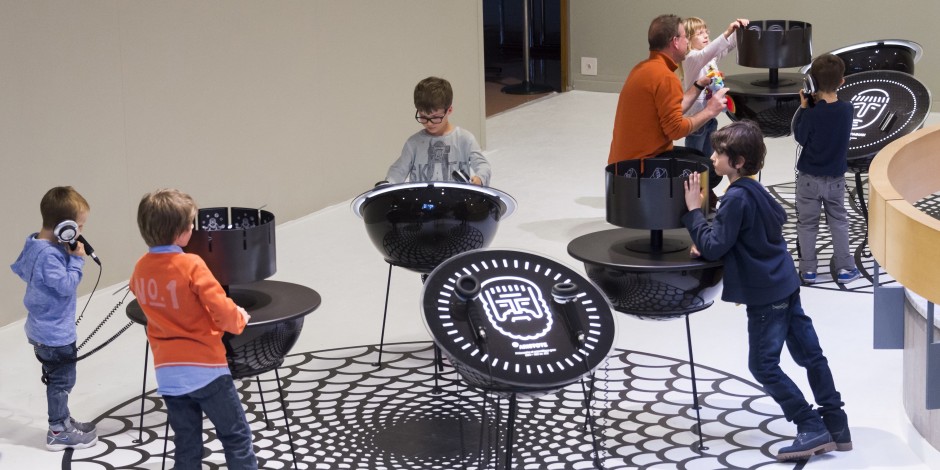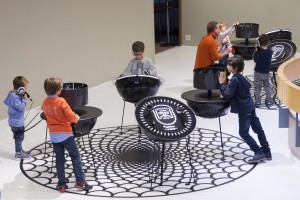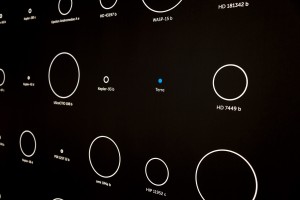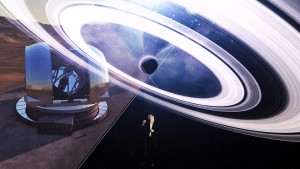Planets for beginners

“When I think that I do not even know what a planet is,” exclaimed Véronique, a specialist in contemporary art, pushing open the doors of “Exoplanets”, the exhibition organized by the Museum of Natural History in Geneva.
It is a gray day and light rain sprinkles the city on this fresh Sunday of April, ideal weather to go to a museum with the family. Children are happy, since many explanations are accompanied by some small entertaining demonstrations, like the one where one can simulate the stability of a planetary system on a tablet screen.
Others have their eyes riveted on a television screen which, thanks to a subtle mixture of real and artist images, reproduces the birth of a planetary system. “It is well done and very spectacular; I have the impression of being there”, enthuses Luke, a computer specialist in his fifties. “I did not know that the stars lighted up suddenly,” says with round eyes his neighbor Félicien, a 13 year-old teenager.
Discoveries abound in the course of the exhibition “Exoplanets”, and all the explanations and animations are containted in half-spheres. “The texts are clear and easy to access” concedes Luz, a nurse who is finding out about planets for the first time, “the hemisphere which explains how long we would take to reach the nearest planet is great – a billion year if we go there walking, it leaves thoughtful. ”
“I wonder if it would not be more efficient to have access to the texts and then study them at home” asks Luke, because in his opinion even if they are short and concise narratives, they deserve more attention. Indeed, the public has a tendency to only read some texts and to proceed to the next step quickly. Almost as if they were convinced that the next hemisphere contains something more interesting or simpler.
Running back-to-back, the spheres follow one another to finish in front of the wall of the planets, a place where the two thousand planets found so far are drawn on a wall about thirty meters long. “It’s beautiful,” insists Luz. “This is amazing, and this little blue dot is us?” asks a surprised Félicien, showing a tiny speck lost in the middle of hundreds of exoplanets much bigger than the Earth.
Then all visitors end their interplanetary travel by the large dark room, a gamble attempted by the designers of the exhibition, since it’s the room that housed the dinosaurs. Exit lizards; they were put in the cellar in wooden crates and in their place a film on giant screen. A film that gives voice to key local planet hunters, Michel Mayor at the head.
“The staging is spectacular of course, but I find that the level of interest is not homogeneous; some are excited and others obviously have nothing to say” relates Véronique. For most visitors, the film has reached its goal, namely providing the dream and provoking thought. “I came away a little less ignorant of the museum. I find this type of exhibition is essential for our general culture, even if we do not understand everything, “concludes Véronique once back on our good old Earth. (pb)
The exhibition, who, what, how
The exhibition «Exoplanets» opened on March 21, 2015 and will close on April 4, 2016. The Natural History Museum of Geneva is located at the Malagnou road No. 1. It is open every day from 10:00 to 17:00 except on Mondays. Admission is free. More information on the website of the museum: www.ville-ge.ch/mhng
A workshop related to the search for exoplanets is offered to children every Wednesday afternoon.
The exhibition «Exoplanets» is organized by the Museum with the participation of the University of Geneva and the NCCR PlanetS, and with the financial support of the Wilsdorf Foundations, Wright and Moser.
Categories: External Newsletter




